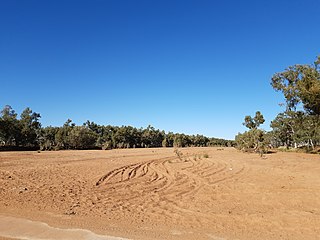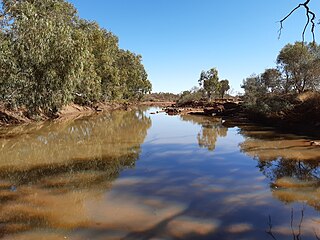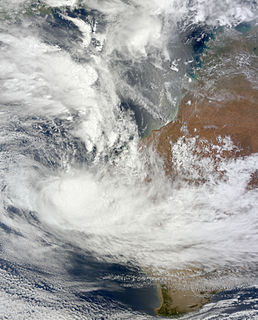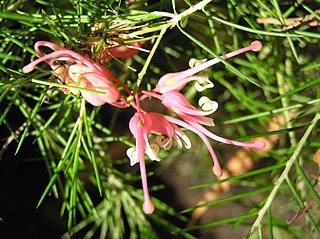| Edmund | |
|---|---|
| Etymology | Admiral Sir Edmund Lyons |
| Location | |
| Country | Australia |
| State | Western Australia |
| Region | Gascoyne |
| Physical characteristics | |
| Source | runoff from the Barlee and Minnierra Ranges |
| • location | north of Barlee Range |
| • coordinates | 23°35′14″S116°22′29″E / 23.58722°S 116.37472°E |
| • elevation | 423 m (1,388 ft) |
| Mouth | confluence with the Lyons River |
• location | east of Oakey Rock |
• coordinates | 23°59′3″S116°1′44″E / 23.98417°S 116.02889°E Coordinates: 23°59′3″S116°1′44″E / 23.98417°S 116.02889°E |
• elevation | 293 m (961 ft) |
| Length | 85 km (53 mi) |
| Basin features | |
| River system | Gascoyne River |
| Tributaries | |
| • left | Edmund Claypan Creek, Donald Creek, Rock Hole Creek, Dingo Creek (Western Australia) |
| • right | Dundagee Creek, Bobbamindagee Creek |
| [1] [2] | |
The Edmund River is a river in the Gascoyne region of Western Australia.
The headwaters of the Edmund rise north of the Barlee Range. The river flows south-west joined by the Dundagee, Edmund Claypan, Bobbamindagee, Rock Hole, Dingo and Donald Creeks until it forms its confluence with the Lyons River. The Lyons continues until it flows into the Gascoyne River. The river descends 130 metres (430 ft) over its 85-kilometre (53 mi) course. [2]
The first European to discover the river was explorer Francis Gregory in 1858. The river was named by Surveyor General John Septimus Roe after the naval hero Admiral Sir Edmund Lyons. [1]

Kennedy Range National Park is a national park in Gascoyne region of Western Australia, approximately 830 kilometres (520 mi) north of Perth and about 150 km (93 mi) east of Carnarvon.
The Gascoyne region is one of the nine administrative regions of Western Australia. It is located in the north west of Western Australia, and consists of the local government areas of Carnarvon, Exmouth, Shark Bay and Upper Gascoyne. The Gascoyne has about 600 km (370 mi) of Indian Ocean coastline; extends inland about 500 km (310 mi); and has an area of 135,073.8 km2 (52,152.3 sq mi), including islands.

The Murchison River is the second longest river in Western Australia. It flows for about 820 km (510 mi) from the southern edge of the Robinson Ranges to the Indian Ocean at Kalbarri. The Murchison-Yalgar-Hope river system is the longest river system in Western Australia. It has a mean annual flow of 208 gigalitres, although in 2006, the peak year on record since 1967, flow was 1,806 gigalitres.

The Gascoyne River is a river in the Gascoyne region of Western Australia. At 865 kilometres (537 mi), it is the longest river in Western Australia.

Gascoyne Junction is a small town in the Gascoyne region of Western Australia, inland from Carnarvon on the junction of the Gascoyne River and Lyons River. At the 2006 census, Gascoyne Junction had a population of 149.

The Lyons River is a river in the Gascoyne region of Western Australia.

The Landor River is a river in the Gascoyne region of Western Australia.
The Thomas River is a river in the Gascoyne region of Western Australia.
The Frederick River is a river that is located in the Gascoyne and Pilbara regions of Western Australia.
The Barton River is a river in the Kimberley region of Western Australia.
The Minilya River is a river in the Gascoyne region of Western Australia.

The 2010 Gascoyne River flood was regarded as the most severe flood to take place along the Gascoyne River in Western Australia on record. Triggered by record-breaking rainfall, amounting to over 6,000 percent of the monthly mean, 313.6 mm (12.35 in) and 5 mm (0.20 in) respectively, in just four days, the floods caused widespread damage in the region. By 17 December, the river began to rise in response to the heavy rains, eventually exceeding its banks within two days. Water levels reached record values at three stations along the river, cresting at 15.53 m (51.0 ft) near Fishy Pool. Evacuation orders were issued for several towns affected by rising waters. The most substantial impact was felt in Carnarvon where entire homes were washed away. Following the disaster, emergency supplies and funds were distributed to affected residents to aid them in restoring their livelihoods. Though no people died in the event, an estimated two thousand head of cattle perished and damage was estimated at A$100 million.
The 1900 Western Australian floods were a series of flooding events from March to May 1900 that affected large areas of Western Australia, primarily in the Pilbara and Gascoyne regions, though it extended to cover most of the state except the more humid Kimberley and South West regions.
Jimba Jimba Station, most often referred to as Jimba Jimba, is a pastoral lease currently operating as a cattle station in Western Australia, that once operated as a sheep station.
Brickhouse Station, formerly spelt Brick House Station, is a pastoral lease in Western Australia. It once operated as a sheep station but now operates as a cattle station, with some 90 ha turned over to mango cultivation.
The Wooramel River is an ephemeral river in the Gascoyne region of Western Australia.

Grevillea deflexa is a species of flowering plant in the family Proteaceae and is endemic to inland areas of central Western Australia. It is a shrub with linear to elliptic or egg-shaped leaves, and groups of red, yellow or red and yellow flowers.
The Tharrkari, also referred to as the Targari, are an Aboriginal Australian people of the Gascoyne region of Western Australia.
The Ninanu were an indigenous Australian people of the Gascoyne region of Western Australia.
The Wariangga, also written Warriyangka, are an indigenous Australian people of the Gascoyne region in Western Australia.